452 Search Results for VISUAL SUPPORTS
October 25, 2012
by Robin Parker -

For AAC Awareness Month, we would be remiss if we did not think about literacy. It is a form of communication and language that supports AAC use. Sometimes literacy is difficult for our students, other times it is actually easier and it helps conversational communication and even natural speech. Either way, reading, writing, talking, and listening (understanding) are all modalities of language. There are so many great resource lists for supporting literacy: Jane Farrall’s Letter of the Week: Resources for Older Students, Spectronics Apps for Literacy Support, Melissa Taylor’s 24 Educational iPad Apps for Kids in Reading and Writing, and 25 Great Children’s Apps to Stimulate Literacy, Learning, & Creativity just to name a few. We wanted to share a few additional resources for literacy with general education apps that approach reading through fun with words. And any literacy discussion could not be complete without some seriously great literacy information, theory, and supports... [Read More...]
October 20, 2012
by Carole Zangari -
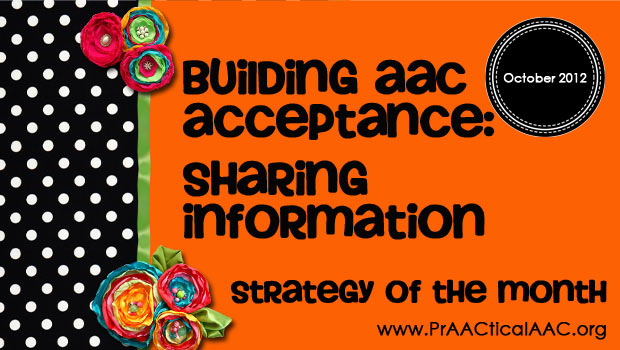
While there are certainly attitudinal barriers to AAC, it’s also true that sometimes the people we are trying to influence just need more information. Sounds simple, right? Not exactly. Especially when we consider these factors. Adult learners prefer to chart their own course to learning new things rather than have others lay that out for them. Our behaviors are most likely to change when we discover solutions for ourselves, as opposed to following directions that others give to us. We have a limited amount of time to guide others to the information they need. Here are some things that have worked for us. Develop a bank of educational materials that pertain to the topics that you face most often in your clinical work. Create resource files for general topics, such as the empirically-supported benefits of AAC, and specific topics, such as the evidence base for using SGDs with individuals who... [Read More...]
September 16, 2012
by Carole Zangari -
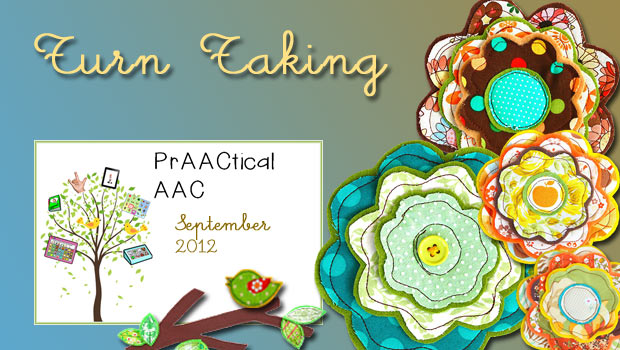
We’re always looking for new ways to represent things visually. Today, we’re sharing an idea from Amy Laurent on helping children take turns. You can view a video explaining the strategy she uses and download the visual support here.
July 28, 2012
by Robin Parker -

Some PrAACtical AAC thoughts about challenging behavior: I wonder if it is ok to say that we love seeing challenging behavior during speech-language therapy sessions or observations. Well, I said it, both of us do, because if we really ‘listen’ then we can figure out what to teach that will really help our students. We tend to prioritize our goals into High Priority and General Priority. Challenging behavior and the communication message behind it, definitely falls into high priority. This is because challenging behavior in students limits experiences, limits interaction, and overall limits opportunities for people to get to know you. Consider Challenging Behavior through Communication Glasses Is it really Challenging Behavior? behavior that is or can be destructive or hurtful. Examples include but are not limited to: hitting, biting, spitting, throwing, pounding, etc. (Note: we are not talking about poor eye contact or poor attention to task or even laughing... [Read More...]
May 24, 2012
by Robin Parker -
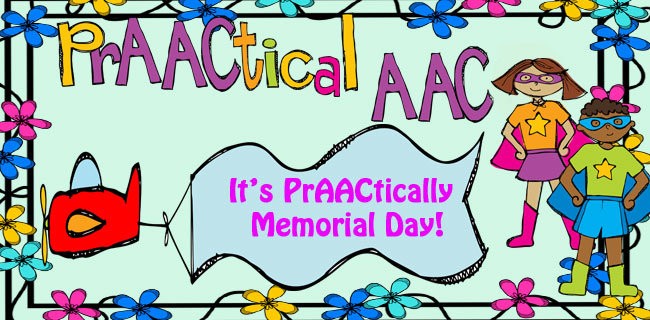
Memorial Day Weekend is big for us. We remember, appreciate, and honor the people who have protected our freedoms. We both have annual relaxing weekends planned. As we started to get ready, though, we started looking for Memorial Day AAC materials. It was surprising to see that there was not much to be found. We found some gluten-casein free Memorial Day recipes, which are great, but what about symbols to go with the recipes or symbols to explain the holiday and what about AAC language activities for the typical long weekend or trip? Not much…. So as we began preparing for our own weekends, these are some of the things we have done or are doing for PrAACtical AAC at home and on our mini-vacations: – Before We Leave Create a personal participation story (modified social story) so ALL the children can SEE the language for the trip. Here’s something that... [Read More...]
April 11, 2012
by Carole Zangari -
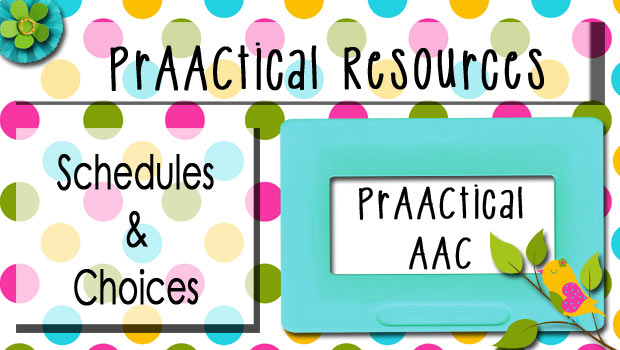
– If you follow our blog, you know that last month we had lots to say on making, teaching, and using Visual Schedules. We ran out of time before we could discuss a question that comes up a lot in our own clinical practice. What role does choice-making play in visual schedules? Here are some of the things we think about when we consider this for the schedules we make and use. We all like to have some say in what we do. Giving the learner an opportunity to make choices in a schedule makes sense when personal autonomy is a priority. Allowing the learner to choose which activities to place on the schedule supports personal autonomy: Having control over what happens in our lives is a big part of happiness for most people. – Here’s how we might do that with a visual schedule for a therapy session. 1.Select... [Read More...]
April 1, 2012
by Carole Zangari -
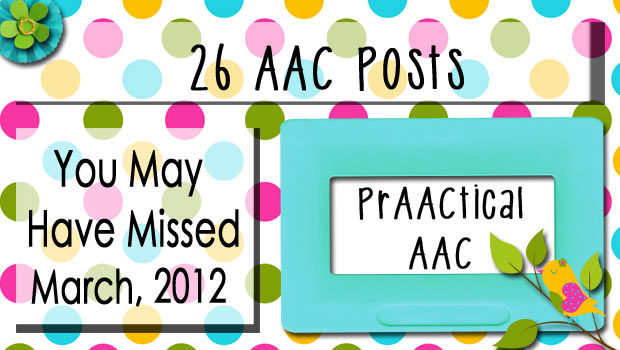
If March was as busy for you as it was for us, then you may have missed some of these posts. Grading exams, meeting with students, clinical paperwork, grant-writing, teaching, travel, etc. Know wonder we’re tired! Enjoy this bit of catch-up. – The Fives 5 Great Resources for Helping Individuals with Vision and Hearing Loss AAC on the Go: 5 Tips for Traveling with AAC Tech it Up’- 5 Visual Schedule Apps 5 Resources for AAC Data Collection 5 Tips to Make AAC Assessments Run Smoothly 5 References to Support AAC Use – PrAACtical Thinking 1. The Secret to Succeeding At Anything 2. National Quilting Day & Employment 3. AAC and March Madness 4. Games are More Than Fun… Gaming for ALL 5. Hearing the Knock 6. HijAACked! AAC & Anti-Bullying with Stand Tall, Mary Lou Melon! 7. Emergencies and Resources to Help 8. Random Acts of Kindness 9. Do... [Read More...]
March 17, 2012
by Carole Zangari -
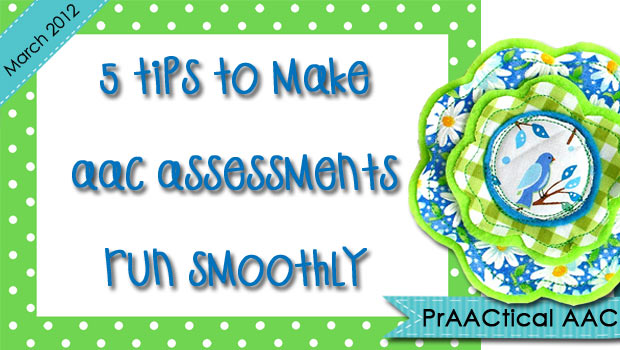
No one likes to be tested, least of all people with communication difficulties who don’t have the tools to express their anxiety or discomfort in the ways they would like to. Some of the people we evaluated had real issues with this and so we’ve experimented with ways to make the testing less stressful and more productive. Here are some of the strategies that we found to be most successful. – 1. Work with the team to establish Fair Testing Practices for the person you’ll be evaluating. Our chapter on ‘Language Assessment for Students Who Use AAC’ describes this in more detail, but essentially it involves writing a ‘rule book’ for how to test this person. It might specify how long the test session can/should be, how to set up the situation so the person can respond, and what other supports are needed so that we are testing the person’s... [Read More...]
February 15, 2012
by Carole Zangari -
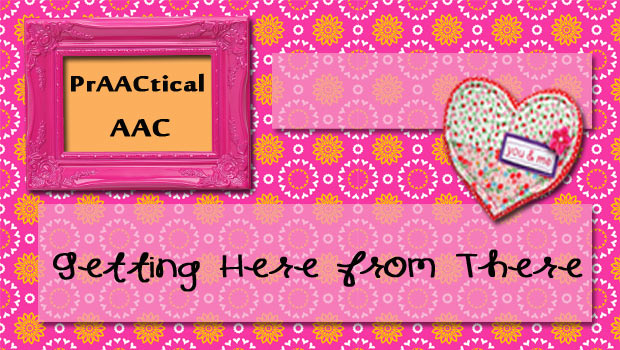
We wanted to take a breather from all the busyness to reflect on the year and to offer up some words of appreciation. For us, 2011 started with our version of a retreat: a long walk in the sun, a half day of venting our frustrations and a half day of planning new projects interspersed with lunch at the beach. (There might have been a bottle of wine in there somewhere, too.) We’d both been feeling more than a bit discouraged that the quality of AAC services is still so spotty. There are some fantastic SLPs and teachers, of course, but not enough to go around. The ‘good ones’ are too busy. And the not-so-good ones were doing too much damage. It seemed to us that too many folks with significant communication challenges weren’t getting what they needed and that stressed us out to no end. Just when we had calmed down, we... [Read More...]
February 3, 2012
by Robin Parker -
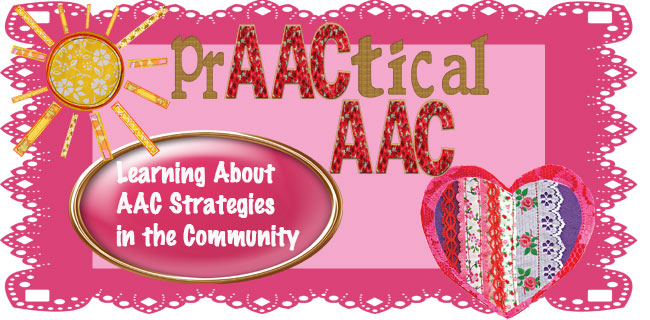
How we integrated AAC strategies into a community event… The name of our website is PrAACtical AAC. We continue to look for ways to make AAC strategies fit praAACtically into ALL activities. We are extremely proud to be part of the Dan Marino Foundation WalkAbout Autism, which is a large South Florida Community Event. The Walkabout helps raise money services for individuals with autism and other developmental disabilities and their families. It also promotes a sense of community collaboration and awareness about autism spectrum disorder and developmental disabilities. We are including this information about the WalkAbout not as a plea for money (although read about the WalkAbout and donate if you are so inclined), but instead to tell you how we are incorporating AAC into community events. This past weekend was the 2nd WalkAbout Autism. It was a truly amazing event and day! There was great music and bounce houses,... [Read More...]









